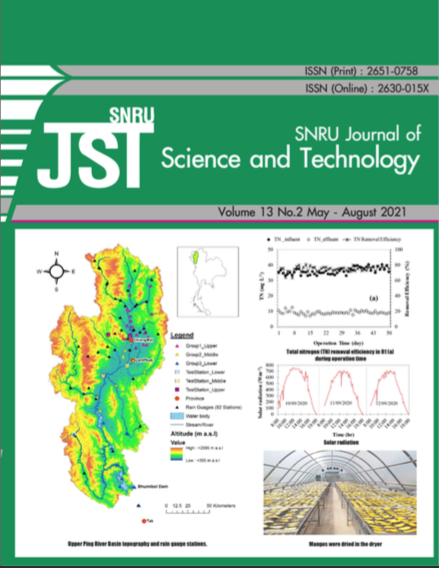Assessing Rural Water Quality: comparing improved and unimproved drinking water sources in Hawul LGA
Keywords:
rural water, improved sources, unimproved sources, water quality, drinking waterAbstract
Rural water quality has been identified as an issue in most developing countries due to the large- scale agricultural activities and presence of industries. These in addition to poor or lack of water treatment facilities exposes rural water sources to contamination. This study analysed the suitability of water sources for drinking within rural settlements in Hawul LGA. Water sources from streams, open hand-dug wells, hand-pumped boreholes, and electrically operated boreholes were collected and analysed for physical, chemical, and bacteriological contaminants. Parameters were analysed using standard laboratory procedures. Water sources were grouped into improved (boreholes) and unimproved (stream and open wells) water sources and analysed using t-Test statistical method to infer if the mean of parameters were statistically greater than the NIS standard guidelines for drinking water. The results indicate that 39.50% of water from unimproved water sources failed to conform to the NIS standards and constitutes to the likelihood of health-related impacts especially water sources from the stream. Stream water sources with mean values 19TCU (colour), 24.70 NTU (turbidity), 92.60 mg L–1 (nitrate), 37.90 mg L–1 (magnesium), 0.30 mg L–1 (lead), 0.30 mg L–1 (manganese), 4.10 mg L–1 (potassium), 0.90 mg L–1 (phosphate), 186.70 mg L–1 (hardness), 4.70 cfu mL–1 (coliform count), and 1.70 cfu mL–1 (E. coli) are all significantly greater than the respective values stipulated by the NIS. However, only manganese and coliform count from hand-operated boreholes (Improved water sources) were found to exceed the stipulated standards. This indicates that only 5.30% of water from improved water sources failed to meet standards. More so, all water samples from electrically operated boreholes adhered to the NIS stipulated guidelines. The results shows that there is a low risk to health associated with water from improved water sources but there is a likelihood of health-related issues associated with water from unimproved sources due to the high values from chemical and bacteriological contaminants.
References
[1] M. Radojevic., V. N. Bashkin. Practical environmental analysis. 2nd ed. Cambridge, UK: Royal Society of Chemistry, 2006.
[2] R. Kumar.,V. Sharma., R. Sharma. Physio-chemical and microbiological water quality of Asan wetland of Garhwal Himalaya, India. Int. J. ecol. Sci. Env. Eng. 5(3) (2018), 64-70.
[3] G. O. Adewuyi., O. U. Oputu., M. A. Opasina. Assessment of groundwater quality and saline intrusion in coastal aquifers of Lagos Metropolis, Nigeria. J. Wat. Res. Prot. 2(2010), 849-853.
[4] The Human Right to Water and Sanitation. https://www.un.org/en/ga/search/view_doc.asp?symbol=A/RES/64/292. 20 October 2020
[5] S. Idris. Determination of seasonal variability of potable water quality in Dustsinma City, Katsina State Nigeria (2015-2018). PhD Thesis Geography Hantoup, University of Gezira, Sudan 2018.
[6] R. Odoh., O. J. Oko., I. S. Udegbunam., C. S. Archibong. Assessment of borehole water quality consumed in Otukpo and its environs. Int. J. Ecol. Sci. Env. Eng. 5(3) (2018), 71-78.
[7] Water, Sanitation, Hygiene, and Waste Management for the
COVID-19 Virus. https://apps.who.int/iris/bitstream/handle/10665/331846/WHO-2019-nCoV-IPC_WASH-2020.3-eng.pdf?ua=1.1 November 2020
[8] A. D. Sutadian., N. Muttil., A. G. Yilmaz. Development of river water quality indices—a review. Environ. Monit. Asses. 188(1) (2016), 1-29.
[9] B. Kimberly., W. Sarah., R. Liz., P. W. Mathew., L. Owen., T. Tim., M. Lindsey. The health and well-being effects of drought: Assessing multi-stakeholder perspectives through narratives from the UK. Clim. Chang. 163(4) (2020), 2073-2095.
[10] M. H. Gholizadeh., A. M. Melesse., L. Reddi. A comprehensive review on water quality parameters estimation using remote sensing techniques. Senso. 16(8) (2016), 1298-1310.
[11] Nigerian Standards for Drinking Water Quality. https://health.gov.ng/doc/standardwaterquality.pdf 25 November 2020
[12] I. R. Abubakar. Strategies for coping with inadequate domestic water supply in Abuja, Nigeria. Wat. Int. 43(5) (2018), 570-590.
[13] C. Cools. Water Quality and Sustainability Assessment of Rural Water Systems in the Comarca Ngäbe-Buglé, Panama. MSc Thesis. University of South Florida USA. 2020
[14] W. K. Joshua. Groundwater quality assessment: a case study of groundwater from hand-dug wells in Hawul Local Government Area of Borno State. Int. J. Adv. Resea. 3(2) (2015), 537-546.
[15] W. S. Bassi., A. K. Monguno., J. S. Bassi. Community participation in environmental conservation and protection: a case study of Kida community, Hawul Local Government Area, Borno State, Nigeria. Asia. J. Env. Ecol. 2(3) (2017), 1-13.
[16] V. Istafanus., S. J. Dukku., H. B. Bwala., M. K. Mangga. Role of local organization in sustainable rural development in Hawul LGA, Borno State, Nigeria. J. Env. Sci. Tox. Food. Tech. 9(12) (2015), 46-51.
[17] Standard Methods for Examination of Water and Wastewater. 19th ed. America Public Health Association, Washington D.C, USA, 1998.
[18] A. K. Gorai., S. A. Hasni., J. Iqbal. Prediction of ground water quality index to assess suitability for drinking purposes using fuzzy rule-based approach. App. Wat. Sci. 6(4) (2016), 393-405.
[19] A. A. Koelmans., N. H. Mohamed Nor., E. Hermsen., M. Kooi., S. M. Mintenig., J. De France. Microplastics in freshwaters and drinking water: Critical review and assessment of data quality. Wat. Resear. 155(2019), 410-422.
[20] R. Bain., R. Cronk., J. Wright., H. Yang., T. Slaymaker., J. Bartram. Fecal contamination of drinking-water in low- and middle-income countries: A systematic review and meta-analysis. PLoS. Med.11(5) (2014), 1- 8









